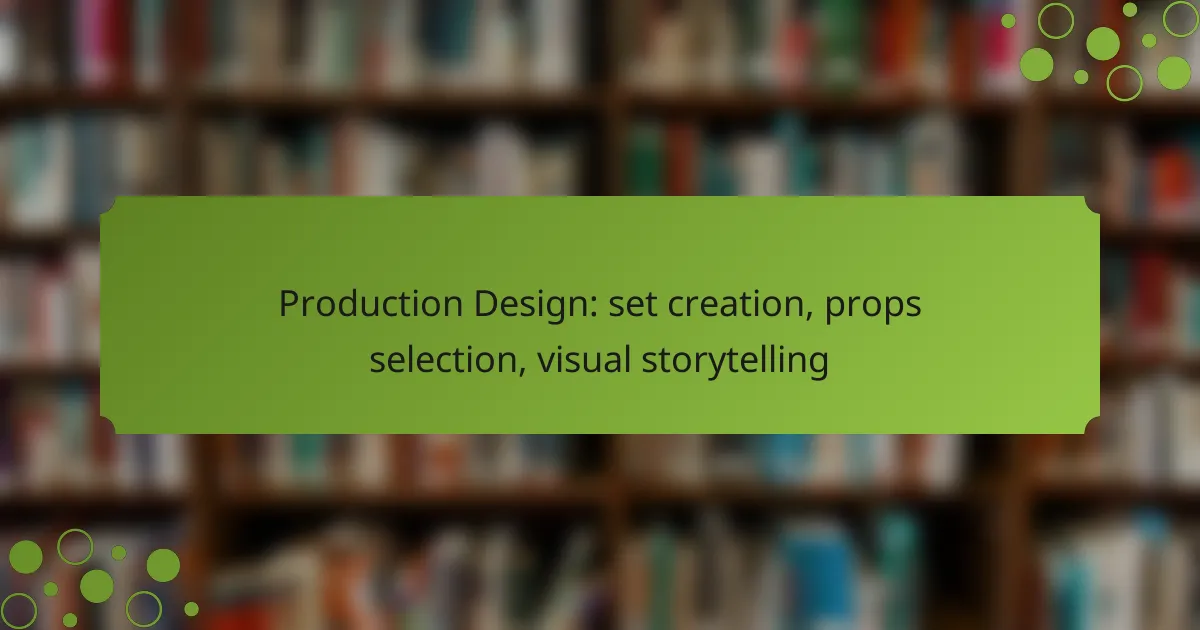Production design plays a crucial role in visual storytelling, encompassing set creation, props selection, and the overall aesthetic of a production. By thoughtfully developing design concepts, planning spatial layouts, and curating props that resonate with the narrative, designers can create immersive environments that engage audiences and enhance the storytelling experience. This meticulous attention to detail not only elevates the production but also fosters a deeper connection with viewers.

How to create effective production designs in Australia?
Creating effective production designs in Australia involves leveraging local resources, incorporating cultural elements, and engaging with regional talent. This approach not only enhances authenticity but also ensures that the design resonates with local audiences.
Utilize local resources
Using local resources can significantly reduce costs and streamline logistics in production design. Consider sourcing materials, props, and set pieces from nearby suppliers or local markets, which often offer unique items that reflect the region’s character.
For example, if your production is set in a coastal town, look for driftwood, shells, or local textiles that can enhance the visual storytelling. This not only supports local businesses but also adds authenticity to your design.
Incorporate cultural elements
Incorporating cultural elements into production design is crucial for creating a relatable and immersive experience. Australia has a rich tapestry of cultures, including Indigenous heritage, which can be reflected in the design through art, color schemes, and traditional motifs.
For instance, using Aboriginal art or symbols in set decoration can provide depth and context, making the story more engaging. Always ensure that cultural elements are used respectfully and accurately, possibly consulting with cultural advisors to avoid misrepresentation.
Engage with regional talent
Engaging with regional talent can bring fresh perspectives and local insights to your production design. Collaborating with local artists, designers, and craftsmen can enhance creativity and ensure that the design aligns with the community’s values and aesthetics.
Consider hosting workshops or open calls for local talent to contribute ideas or materials. This not only fosters community involvement but also enriches the production with diverse viewpoints, making the final design more compelling and authentic.

What are the key elements of set creation?
Set creation involves several key elements that work together to establish the visual narrative of a production. These elements include design concept development, spatial layout planning, and color palette selection, each contributing to the overall storytelling and audience engagement.
Design concept development
Design concept development is the initial phase where the vision for the set is established. This involves brainstorming ideas that align with the script, themes, and character arcs. Collaborating with directors and production designers helps refine the concept into a cohesive vision.
Consider creating mood boards or sketches to visualize the concept. This can include references from art, architecture, or even other films. A well-defined concept serves as a guide throughout the production process, ensuring consistency and clarity.
Spatial layout planning
Spatial layout planning focuses on the arrangement of set elements to optimize the use of space. This includes determining the placement of key props, furniture, and backdrops to enhance the flow of action and visibility for the camera. Effective layout planning can significantly impact the pacing and dynamics of scenes.
Utilize floor plans and 3D modeling software to visualize the layout before construction begins. Consider factors such as sightlines, actor movement, and camera angles. A well-planned layout minimizes disruptions during filming and enhances the overall production efficiency.
Color palette selection
Color palette selection is crucial for establishing the mood and tone of the set. Colors can evoke emotions and influence the audience’s perception of characters and situations. Choosing a harmonious color scheme that aligns with the narrative can enhance visual storytelling.
When selecting colors, consider the psychological effects of different hues and how they interact with lighting. Create a palette that includes primary, secondary, and accent colors to maintain visual interest. Test colors in the actual set lighting to ensure they achieve the desired effect on camera.

How to select props for visual storytelling?
Selecting props for visual storytelling involves choosing items that enhance the narrative and resonate with the audience. Effective prop selection can significantly influence the mood, setting, and character development in a production.
Research thematic relevance
Understanding the thematic relevance of props is crucial for effective visual storytelling. Props should align with the story’s themes, characters, and settings to create a cohesive narrative. For example, a vintage typewriter can symbolize nostalgia in a drama, while a futuristic gadget may enhance a sci-fi narrative.
Consider the emotional tone and context of the scene when selecting props. Items that evoke specific feelings or memories can deepen audience engagement and enhance the storytelling experience.
Source from local suppliers
Sourcing props from local suppliers can save costs and foster community relationships. Local vendors often have unique items that reflect regional culture, adding authenticity to the production. This can be particularly beneficial for films or plays set in specific locales.
Additionally, working with local suppliers can streamline logistics, reducing shipping times and costs. Establishing partnerships with nearby businesses can also lead to more sustainable production practices.
Assess durability and usability
When selecting props, it’s essential to assess their durability and usability. Props should withstand the rigors of production, including repeated handling and potential wear and tear. For instance, lightweight materials may be suitable for certain scenes, while sturdier options are necessary for action sequences.
Evaluate how easy the props are to use in the context of the performance. Items that are difficult to handle or manipulate can disrupt the flow of a scene. Always consider the practical aspects of each prop to ensure they contribute positively to the storytelling process.

What are the best practices for visual storytelling?
The best practices for visual storytelling focus on creating a cohesive narrative that engages the audience through thoughtful design elements. This involves using visual cues, symbols, and consistent aesthetics to enhance the story being told.
Establish a narrative arc
Establishing a narrative arc is crucial for guiding the audience through the story. This arc typically includes a beginning, middle, and end, allowing viewers to connect emotionally with the characters and events. Consider using key scenes to highlight pivotal moments that drive the narrative forward.
To effectively create a narrative arc, outline the main events and identify how each scene contributes to the overall story. Use visual elements such as lighting and color to signify shifts in tone or emotion, enhancing the audience’s understanding of the plot’s progression.
Use symbolism in design
Symbolism in design can add depth to visual storytelling by conveying themes and emotions without explicit dialogue. Objects, colors, and settings can represent broader concepts, allowing viewers to interpret meaning on multiple levels. For example, a red rose might symbolize love, while a stormy sky could represent conflict.
When incorporating symbolism, ensure that the elements are relevant to the story and resonate with the audience. Avoid overcomplicating symbols; instead, aim for clarity and relatability to enhance the viewer’s experience and connection to the narrative.
Maintain visual consistency
Maintaining visual consistency is essential for creating a unified look and feel throughout the production. This includes using a cohesive color palette, consistent typography, and similar design styles across sets and props. Consistency helps the audience stay immersed in the story without distraction.
To achieve visual consistency, develop a style guide that outlines the key design elements to be used throughout the production. Regularly review scenes to ensure that all visual components align with the established aesthetic, making adjustments as needed to uphold the overall vision.

What tools can enhance production design?
Production design can be significantly improved with the right tools, which facilitate the visualization and execution of creative concepts. Utilizing software for 3D modeling, layout design, and graphic creation streamlines the process and enhances the overall aesthetic of a project.
Cinema 4D for 3D modeling
Cinema 4D is a powerful tool for creating detailed 3D models that can bring set designs to life. It offers a user-friendly interface and a range of features such as sculpting, texturing, and lighting, which are essential for visual storytelling.
When using Cinema 4D, consider starting with basic shapes and gradually adding complexity. This approach helps in managing the learning curve while allowing for creative experimentation. Additionally, leveraging its rendering capabilities can provide realistic previews of your designs.
SketchUp for layout design
SketchUp is ideal for layout design, enabling production designers to create accurate floor plans and spatial arrangements. Its intuitive drag-and-drop functionality allows for quick adjustments and visualizations of set layouts.
To maximize SketchUp’s potential, utilize its extensive library of pre-made models for furniture and props. This can save time and help maintain consistency in design. Remember to regularly check dimensions to ensure that all elements fit within the intended space.
Adobe Creative Suite for graphics
Adobe Creative Suite, particularly Photoshop and Illustrator, is essential for creating graphics that complement production design. These tools allow for the design of promotional materials, set graphics, and visual effects that enhance storytelling.
When using Adobe tools, focus on maintaining a cohesive visual style that aligns with the overall theme of the production. Utilize layers and smart objects to keep designs flexible and editable. Additionally, consider exporting graphics in various formats to ensure compatibility across different platforms and uses.

What criteria should be considered in production design courses?
Production design courses should focus on practical skills, industry standards, and creative approaches to set creation and prop selection. Key criteria include curriculum relevance and instructor experience, which significantly impact the quality of education and preparedness for real-world projects.
Curriculum relevance
A relevant curriculum in production design should cover essential topics such as visual storytelling, set construction techniques, and prop sourcing. Courses should integrate hands-on projects that mimic industry practices, allowing students to apply theoretical knowledge in practical settings.
Additionally, staying updated with current trends and technologies in production design is crucial. Incorporating digital tools like 3D modeling software and virtual reality can enhance learning and better prepare students for modern production environments.
Instructor experience
Instructors with substantial industry experience bring valuable insights and practical knowledge to production design courses. Their backgrounds can provide students with real-world examples and case studies that enrich the learning experience.
When evaluating instructors, consider their professional achievements, network connections, and teaching styles. Engaging educators who have worked on notable projects can inspire students and offer them unique perspectives on the production design process.
